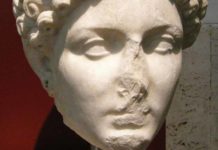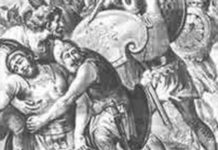Many cultures interacted in the Roman province of Africa, centred upon the region known as Africa Proconsularis (i.e. modern Tunisia and northern Libya)
Prior to the Roman defeat of the Carthaginians in 146 BC, this area had been the centre of the Punic state and the only serious rival to Roman expansion in the Mediterranean. Situated on what is today the Gulf of Tunis, Carthage had been founded in c. 814 BC, supposedly by queen Dido, daughter of the king of Tyre. (Tyre was located in Phoenicia in what is now Lebanon; the word “Punic” derives from “Phoenicia”.)
The proven element of this legend is that Carthage and other settlements such as Sabratha, Oea and Leptis Magna, were indeed founded by Phoenician settlers primarily as trading posts; while Carthage and other towns in the area were governed by suffete, a Phoenician title of governor. To the east of Africa Proconsularis was Cyrenaica, an area strongly influenced by the Greek culture of its ruling class, while on the western side was the Berber kingdom of Numidia.
Phoenician and Egyptian Influence
Monuments that pre-date the Roman conquest show identifiable cultural influences. For example, a number of Punic grave markers exist which have features derived from Phoenician and Egyptian culture. Strong Phoenician influence is evident in the depiction of Tanit, the patroness goddess of Carthage and her symbol, the crescent, on stones from Constantine, Algeria. The crescent motif is very persistent in African decoration, occurring on African slipware jugs of the third century AD. Each stone also has an inscription in Phoenician script. Possible Egyptian influence is the presence on some of the stones of a zigzag and egg and dart frieze, but the strongest influence evident on these stones is Phoenician.
Acculturation in Roman North Africa
Numerous votive stones have been found in Roman North Africa dating typically from late first to second century. These are stones erected to confirm a vow or commemorate a successful outcome. They clearly show that Roman control of the area had by now brought about acculturation whereby people wealthy enough to erect such stones had adopted at least the trappings of Roman culture. It also shows that a fusion of religious forms and deities had occurred and many stones share similar details.
A votive stone from Ain Meghrawi in Tunisia is a typical example and is worth describing. Tall, with a triangular pointed top, in the tradition of the earlier Punic grave markers and the architecture of the Mausoleum of Ateban in Thugga, it commemorates in Latin the fact that someone called Rogatus fulfilled his vow with a willing spirit. This type of statement confirming Roman-style worship appears on other votive tablets elsewhere in the Roman empire, for example at Maryport fort on Hadrian’s Wall.
Rogatus himself is shown in the Roman manner, seated in an aedicule and wearing a toga. His name appears to be Roman (meaning “asked or wished for” and lacks “…son of…” which is generally an African form of naming and present on many other stones. Being a single name, however, it could mean someone African by descent.
Roman and Punic symbolism
Above the figure of Rogatus, the temple ceiling is shown on the same plane as the front of the temple, indicating a misunderstanding of perspective on the part of the sculptor but the pattern seems to have become one of the standard features of local votive stones. A man is shown leading a bull to sacrifice according to Roman ritual but the sculptor is clearly not confident about how to show the movement of the bull in the classical manner, the result being that both figures are depicted in a non-classical manner. At the top of the stone, over a Roman-style pediment, are three deities; the most important, Caelestis, appears at the top with Graeco-Roman gods Dionysus and Hercules below, to left and right respectively and identified by their traditional attributes.
Here, Caelestis broadly resembles the shape of the sign of Tanit, with arms raised in the manner of the Tanit figures on the earlier Punic grave markers. The Phoenician moon goddess became assimilated with the Roman goddess Juno, becoming Juno-Caelestis in Roman North Africa. Here she appears to be holding a crescent moon and is surrounded by what may be fruits symbolising fertility. The deities face forward, giving an overall impression of pattern rather than naturalism or narrative and exemplify combined classical and Punic figures of worship, depicted in Punic or non-classical style.
In conclusion, when Rome took control of Africa in 146 BC its primary concern was economic, maintaining its grain, oil and wine imports to Italy. African Roman coins frequently show a personification of Africa wearing an elephant headdress together with an ear of grain, plough or modius (grain measure). The developed culture in a number of towns near the coast appears to have enabled Roman control to become established fairly readily, although this is a huge generalisation; but there is evidence to suggest that the ruling classes at any rate aspired to those aspects of Graeco Roman culture which they felt would be of benefit to themselves, having already been exposed to the culture through trade.
For instance, the former king of Numidia, Juba II (r. 30-23 BC), encouraged the spread of Roman law and was also a patron of Greek art. He fought on the Roman side against the rebel Tacfarinas and incurred the antagonism of local tribes who resented his opposition to their traditional nomadic habits. Although towns such as Thugga contain evidence of Roman styles of buildings, public inscriptions and dress (e.g. Rogatus above), they are associated almost exclusively with the elite and there is a strong feeling that the nomadic tribes were tolerated providing they did not encroach upon the “Romanised” settlements. Likewise, the nomads tried to stop Romanisation from interfering with their traditional way of life.
In towns such as Thugga, there is strong evidence of acculturation so that distinctive African traits are distinguishable in a Romanised context. For example, although the administrative language was Latin, the Punic style of government under suffete persisted well into the Roman period. It is also extremely unlikely that African dialects were not the normal language of most of the townsfolk throughout the Roman period, with the addition of some Latin words, as was the case in other parts of the Roman empire.








